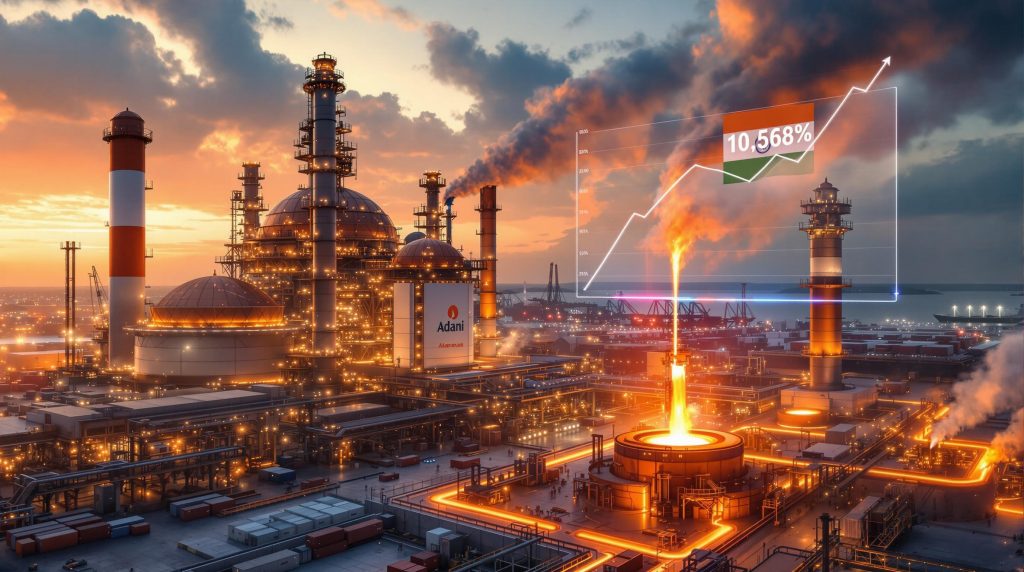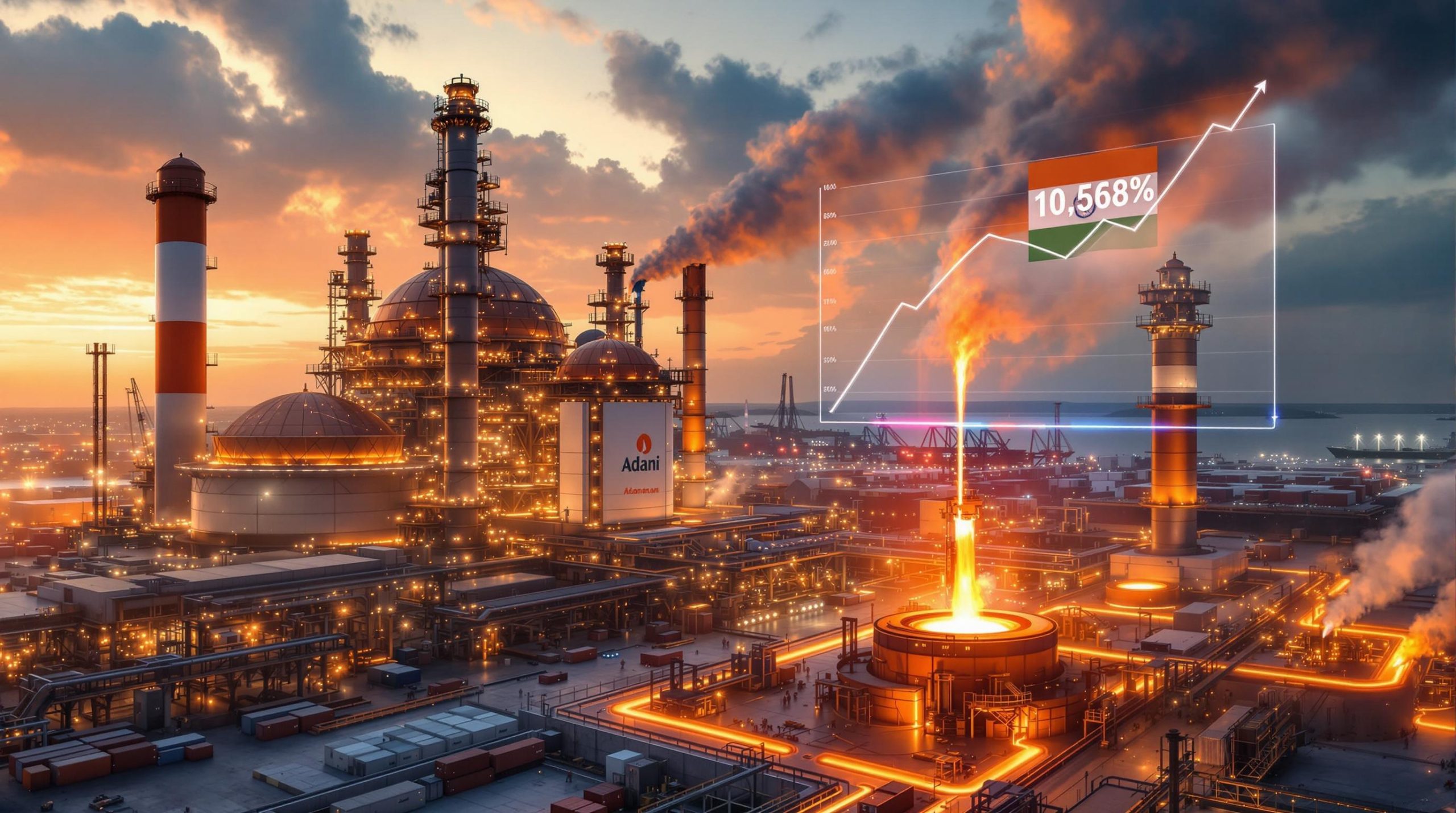Adani's New Copper Smelter in India: Strategic Expansion and Global Impact
India's industrial landscape is undergoing a significant transformation with the development of what's being touted as the world's largest single-location copper smelting facility. Located in the western state of Gujarat, Adani Enterprises Ltd's $1.2 billion Kutch Copper facility represents a bold step toward reducing the country's dependency on imported copper while positioning India as a potential future exporter in the global copper market.
What is Adani's Kutch Copper Facility?
Situated in the industrial region of Kutch, Gujarat, this massive copper smelting facility stands as a testament to India's growing industrial ambitions. With an annual production capacity of 500,000 metric tons, the facility is designed to address India's substantial copper deficit while creating a new industrial hub in western India.
The $1.2 billion investment by Adani Enterprises represents one of the largest commitments to metal refining infrastructure in India's recent history. The strategic positioning of the facility in Gujarat offers significant logistical advantages, including proximity to major ports for both importing concentrates and exporting refined copper products.
Project Timeline and Development Status
According to Felipe Williams, Adani's head of metals, the facility "is expected to begin smelting in May" 2025, following the completion of construction in early 2025. The project has adhered to its ambitious timeline despite the complexity of building such a large-scale metallurgical facility.
The Kutch Copper facility is currently in the process of securing international certifications and listings that will enable it to participate fully in global copper markets. This includes its recent application to become a London Metal Exchange (LME) registered brand, which would significantly enhance the marketability and trading potential of its copper products.
Why is the LME Listing Application Significant?
The London Metal Exchange (LME) is the world's most important trading venue for industrial metals, including copper. Adani's application to register its Kutch Copper brand with the LME represents a strategic move to integrate its production into the global copper trading ecosystem.
Benefits of LME Brand Registration
LME registration offers several critical advantages for a copper producer. As Reuters noted, "Copper listed for storage in LME-registered warehouses can be delivered against copper futures traded on the exchange when their contracts expire. For market players, LME-listed copper is easier to finance than non-registered brands."
This enhanced marketability translates into tangible business benefits, including:
- Premium pricing potential for LME-registered copper brands
- Improved financing terms from banks and commodity trading firms
- Simplified hedging opportunities for both Adani and its customers
- Greater access to international markets through the LME's global network
Global Trading Advantages
The LME listing would also position Adani's copper within the international metals trading infrastructure, providing:
- Streamlined delivery mechanisms through LME's warehousing system
- Reduced counterparty risk for buyers of Adani copper
- Enhanced price discovery through transparent trading mechanisms
- Integration into established copper supply chains across Asia, Europe, and North America
For a new market entrant like Adani's Kutch Copper, achieving LME brand status would represent a significant validation of its production quality and operational standards.
How Will This Impact India's Copper Market?
India has long struggled with a significant gap between domestic copper demand and production capacity. The Kutch Copper facility aims to address this imbalance by substantially increasing the country's refined copper output.
Current Import Dependency
According to trade data cited by Reuters, India imported refined copper worth $2.8 billion in 2024, with Japan, Tanzania, and Mozambique serving as the primary suppliers. This dependency on imports has exposed Indian manufacturers to price volatility and supply uncertainty, especially during periods of global logistics disruptions.
The country's manufacturing sector, particularly in electrical equipment, electronics, and construction, has faced challenges related to copper availability and price volatility. These industries are critical to India's economic growth ambitions and require stable access to high-quality copper products.
Economic Benefits for India
The introduction of 500,000 metric tons of domestic copper capacity could significantly reduce India's reliance on imports. At full production, the Kutch facility could potentially substitute up to 40% of India's current copper imports, representing a substantial reduction in the country's trade deficit for this critical industrial metal.
Beyond direct import substitution, the establishment of this world-class copper facility is expected to generate:
- Job creation across both direct employment and supporting industries
- Industrial cluster development in the Gujarat region
- Enhanced supply security for India's manufacturing sector
- Technology transfer in advanced metallurgical processes
- Skills development in technical and engineering fields
The downstream effects could be even more significant, potentially catalyzing the growth of copper-dependent manufacturing sectors throughout India's industrial corridors.
What Are the Supply Partnerships for the Smelter?
Securing reliable copper concentrate supply is critical for any copper smelter's success. Adani has been proactive in establishing strategic supply relationships to ensure the facility's operational stability.
Strategic Concentrate Supply Agreements
A significant development in Adani's supply strategy came in April 2025, when "Chilean copper mining giant Codelco said it would begin supplying copper concentrates to the smelter for refining this year," according to Reuters. This partnership with one of the world's largest copper producers represents a major vote of confidence in Adani's new facility.
The Codelco copper strategy demonstrates Adani's ability to secure supplies from premium global sources, which is essential for maintaining consistent quality and production volumes. Such partnerships are typically structured as long-term supply agreements that provide stability for both the miner and the smelter.
Domestic Mining Integration Possibilities
While the facility will initially rely heavily on imported concentrates, there is potential for increased integration with India's domestic copper mining operations over time. This could include:
- Partnerships with smaller Indian copper miners to process locally-produced concentrates
- Development of new mining projects specifically to supply the Kutch facility
- Investment in mineral exploration to identify new copper resources within India
- Processing of complex or lower-grade domestic ores that were previously uneconomical
Such vertical integration would further enhance India's copper self-sufficiency while reducing logistics costs and environmental impacts associated with long-distance concentrate transportation.
What Challenges Does the Smelter Face?
Despite its strategic importance and scale advantages, the Kutch Copper facility faces several significant challenges as it prepares to enter production.
Market Timing Considerations
As Reuters observed, the copper smelter "is coming online at a time of shrinking smelting margins due to new smelter capacity in China and slower-than-expected growth of copper concentrate supply." This challenging market environment could impact the facility's initial profitability and ramp-up schedule.
The global copper smelting landscape has evolved significantly in recent years, with:
- Substantial new capacity additions in China and elsewhere
- Intensifying competition for copper concentrates
- Fluctuating treatment and refining charges (TC/RCs)
- Volatile refined copper premiums in key markets
These market conditions may require Adani to demonstrate exceptional operational efficiency to achieve competitive production costs during the facility's early years.
Environmental and Regulatory Factors
Modern copper smelters must meet increasingly stringent environmental standards, requiring substantial investment in pollution control technologies and systems. While specific details about the Kutch facility's environmental controls aren't provided in the source material, it would need to address:
- Sulfur dioxide emissions management
- Wastewater treatment and recycling
- Energy efficiency optimization
- Solid waste disposal and potential recovery of valuable by-products
These environmental considerations represent both challenges and opportunities, as state-of-the-art environmental systems can actually enhance operational efficiency and by-product recovery while ensuring regulatory compliance.
How Does This Fit Into Adani's Business Strategy?
The Kutch Copper facility represents a significant diversification move for Adani Enterprises, expanding its portfolio beyond its traditional strengths in energy, ports, and infrastructure.
Diversification Beyond Coal and Ports
By entering the copper smelting business, Adani is strategically positioning itself in a sector with strong growth potential driven by the global electrification trend. This diversification:
- Reduces dependency on carbon-intensive businesses
- Aligns with global energy transition themes
- Creates synergies with existing logistics and energy assets
- Establishes presence in critical materials supply chains
The move into copper processing demonstrates Adani's recognition of the changing global industrial landscape and the increasing importance of metals that support renewable energy and electrification technologies.
International Growth Ambitions
The LME listing application signals Adani's intention to become a global player in the copper market rather than focusing solely on domestic Indian demand. This international outlook could pave the way for:
- Expansion of trading and marketing operations globally
- Strategic partnerships with international miners and metals traders
- Potential future investments in copper processing facilities in other regions
- Enhanced visibility in global commodity markets
Success in the copper smelting business could provide Adani with valuable experience and credentials for further expansion into other industrial metals and minerals processing.
What Is the Global Context for Copper Smelting?
Adani's entry into copper smelting comes at a time of significant change in the global copper industry, with shifting supply-demand dynamics and evolving technological approaches.
Industry Trends and Capacity Expansion
The copper smelting landscape has seen considerable change in recent years, with China dominating capacity additions while older facilities in developed economies face increasing cost and regulatory pressures. Key trends include:
- Concentration of new capacity in Asia, particularly China
- Increasing scale of new smelting facilities
- Technological advancements in smelting efficiency
- Growing focus on reducing environmental footprints
The Kutch facility appears to be aligned with these trends, leveraging scale and presumably incorporating modern technology to achieve competitive performance.
Supply-Demand Dynamics
The fundamental outlook for copper remains strong, driven by:
- Accelerating electrification across transportation and energy systems
- Expansion of renewable energy infrastructure
- Continuing urbanization in developing economies
- Challenges in developing new mining projects due to declining ore grades and rising development costs
These factors suggest robust long-term demand for copper, even as the market experiences cyclical fluctuations in the near term. The Reuters report specifically noted "slower-than-expected growth of copper concentrate supply," highlighting the ongoing challenges in expanding mine production to meet refining capacity.
How Will This Affect Global Copper Markets?
The introduction of a 500,000-ton capacity smelter will have ripple effects throughout regional and potentially global copper markets.
Price and Supply Implications
The addition of significant new smelting capacity could influence several market dynamics:
- Potential downward pressure on treatment and refining charges as competition for concentrates intensifies
- Increased refined copper availability in Asian markets
- Potential shifts in regional price differentials
- Changes in trade flows as India reduces import dependency
The magnitude of these effects will depend on how quickly the facility ramps up to full production and how effectively it secures concentrate supplies.
Competitive Positioning
The Kutch Copper facility enters a competitive landscape dominated by established players with decades of operational experience. Its competitive position will be determined by:
- Production costs relative to global peers
- Product quality and consistency
- Supply chain efficiency for both inputs and outputs
- Operational reliability during the critical ramp-up phase
As a new entrant with state-of-the-art facilities, Adani may enjoy certain advantages over older smelters but will need to rapidly build operational expertise and market relationships.
What Are the Investment Implications?
The Kutch Copper project represents a significant capital allocation decision for Adani Enterprises, with both opportunities and risks for the company and the broader sector.
For Adani Enterprises
The $1.2 billion investment in copper smelting offers Adani:
- Revenue diversification into industrial metals
- Vertical integration opportunities with other parts of the Adani business ecosystem
- Exposure to electrification and renewable energy supply chains
- Potential for margin expansion through operational efficiencies and by-product recovery
The success of this venture will depend significantly on Adani's ability to achieve operational excellence in a business that requires specialized metallurgical expertise.
For the Broader Metals Sector
The entry of a major new player could influence the competitive dynamics in several ways:
- Increased pressure on less efficient smelters
- Shifting balance of power between miners and smelters in concentrate negotiations
- New performance benchmarks for operational scale and efficiency
- Potential acceleration of industry consolidation
The Kutch facility's development will be closely watched by industry participants as an indicator of changing competitive dynamics in the copper processing sector.
FAQ: Adani's Copper Smelter Project
What makes the Kutch Copper facility unique?
The facility stands out due to its status as "the world's biggest single-location plant of its type" according to Reuters. This scale, combined with its modern design and strategic location in Gujarat's industrial corridor, positions it uniquely in the global copper smelting landscape.
When will the facility reach full production capacity?
According to Adani's head of metals, Felipe Williams, the facility "is expected to begin smelting in May" 2025. A typical ramp-up period for a copper smelter of this scale would likely extend over 12-18 months, suggesting full capacity could be achieved by late 2026, though this timeline could vary based on operational factors.
How does this project compare to other recent copper smelters?
At 500,000 metric tons annual capacity, the Kutch facility is significantly larger than most recent copper smelter projects. This scale offers potential efficiency advantages but also presents operational challenges during the commissioning and ramp-up phases.
What impact will this have on India's copper self-sufficiency?
With India importing $2.8 billion worth of refined copper in 2024, the Kutch facility's 500,000-ton capacity could substantially reduce this import dependency. At full production, it could potentially substitute up to 40% of current imports, dramatically improving India's copper self-sufficiency.
The Future of Copper in India's Industrial Landscape
Adani's new copper smelter in India represents more than just a new industrial facility—it signals India's intention to become a significant player in the global copper market. As the facility moves toward production in 2025, its impact will extend from local economic development in Gujarat to potentially reshaping regional copper trade flows across Asia.
The project's success will ultimately depend on Adani's ability to navigate challenging market conditions, secure reliable concentrate supplies, and achieve operational excellence in a highly competitive global industry. If successful, the Kutch Copper facility could serve as a template for India's broader ambitions in industrial metals processing and manufacturing.
Industry analysts are already developing copper price predictions that take into account this significant new production capacity. Meanwhile, market participants are carefully monitoring the global copper supply forecast to understand how Adani's facility will affect regional balance.
The timing is particularly interesting given recent developments like the Glencore smelter shutdown in Chile, which could create additional market opportunities for new entrants like Adani. Furthermore, investors are increasingly looking at copper and uranium investments as strategic plays in the growing clean energy transition.
Disclaimer: This article contains forward-looking statements regarding production timelines, market impacts, and economic benefits. Actual outcomes may vary based on market conditions, operational factors, and regulatory developments. Readers should consider this analysis as informational rather than investment advice.
Investing in Copper Stocks but Missing Major Discoveries?
Discovery Alert's proprietary Discovery IQ model delivers real-time alerts on significant ASX mineral discoveries, turning complex data into actionable insights for both copper and other commodity opportunities. Understand why major mineral discoveries can lead to significant market returns by exploring Discovery Alert's dedicated discoveries page, showcasing historic examples of exceptional outcomes.




